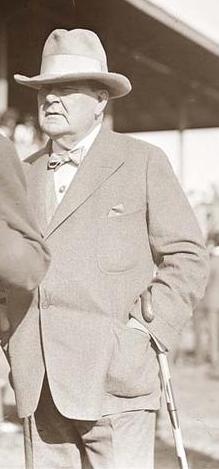James Buchanan Brady
| James B. Brady | |
|---|---|

Diamond Jim Brady c. 1900
|
|
| Born |
James Buchanan Brady August 12, 1856 New York City, New York, United States |
| Died | April 13, 1917 (aged 60) Atlantic City, New Jersey, United States |
| Cause of death | Myocardial infarction |
| Body discovered | Shelburne Hotel |
| Resting place |
Holy Cross Cemetery 40°38′49″N 73°56′17″W / 40.64694°N 73.93806°W |
| Other names |
|
| Occupation |
|
| Years active | 61 |
| Known for |
|
| Parent(s) |
|
James Buchanan Brady (August 12, 1856 – April 13, 1917), also known as Diamond Jim Brady, was an American businessman, financier and philanthropist of the Gilded Age.
Brady was born in New York City to an Irish immigrant family.
Brady worked his way up from bellhop and courier. After gaining employment in the New York Central Railroad system, he became the chief assistant to the general manager by the age of 21. At 23, Brady parlayed his knowledge of the rail transport industry and its officials to become a highly successful salesman for Manning, Maxwell and Moore, a railroad supply company. In 1899 he became Sales Agent for the Pressed Steel Car Company.
Known for his penchant for jewels, especially diamonds, he collected precious stones and jewelry in excess of US$2 million (equivalent to approximately $57,576,000 in 2016 dollars).
Brady's enormous appetite was as legendary as his wealth, though modern experts believe it was greatly exaggerated. It was not unusual, according to the legend, for Brady to eat enough food for ten people at a sitting. George Rector, owner of a favorite restaurant, described Brady as "the best 25 customers I ever had". For breakfast, he would eat "vast quantities of hominy, eggs, cornbread, muffins, flapjacks, chops, fried potatoes, beefsteak, washing it all down with a gallon of fresh orange juice". A mid-morning snack would consist of "two or three dozen clams or Lynnhaven oysters". Luncheon would consist of "shellfish...two or three deviled crabs, a brace of boiled lobsters, a joint of beef, and an enormous salad". He would also include a dessert of "several pieces of homemade pie" and more orange juice. Brady would take afternoon tea, which consisted of "another platter of seafood, accompanied by two or three bottles of lemon soda". Dinner was the main meal of the day, taken at Rector's Restaurant. It usually comprised "two or three dozens oysters, six crabs, and two bowls of green turtle soup. Then in sumptuous procession came six or seven lobsters, two canvasback ducks, a double portion of terrapin, sirloin steak, vegetables, and for dessert a platter of French pastries." Brady would even include two pounds of chocolate candy to finish off the meal.
...
Wikipedia
